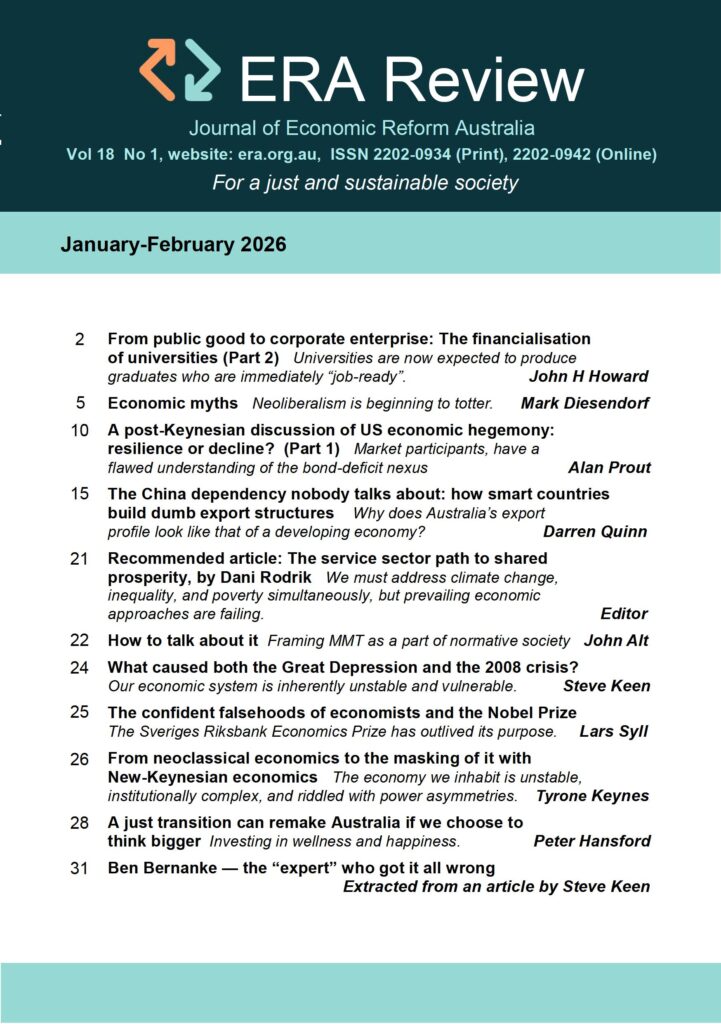Intergenerational Report nonsense
Excerpts from a blog by Bill Mitchell
It appears that few people have read and digested the 170-page “Intergenerational Report 2015” issued by the Australian Treasury. A recent blog by Prof Bill Mitchell [1] which appeared on 6th March has commented on the fact that the whole nation nevertheless has become caught up in the doom and gloom that the federal government is putting out about projected budget deficits for the next 40 years. Not a fiscal surplus in sight.
According to Bill Mitchell: “ … at the same time, all this is based on (using their own logic) an assumption that we will be back in a steady inflation, full employment Australia within 5 years and sustain that state for the projection period out to 2054-55.
Question: What would be so wrong with that? Of course, that statement just assumes their own logic. The projections however are not mutually consistent and there is insufficient information about net export trends for us to under- stand whether a fiscal deficit of 6 per cent of GDP in 2054-55 (on current legislation) is suitable or not. But again, if that size deficit is producing full employment and price stability, why all the ‘sky is about to fall in’ unless we produce fiscal surpluses as quickly as possible? Answer: this is a nonsensical political exercise and has little to do with economics. “
Bill then went on to do calculations based on the assumptions made in the IGR 2015, to check on the internal consistency. Here is part of what he found:
“ First, the IGR just assumes away the problem of unemployment and says:
As a result of the constant unemployment assumption, employment growth from 2020-21 onwards (where the economy is projected to return to full employment) reflects growth in the labour force.
“ What is this constant unemployment assumption? The unemployment projections in the IGR are based on the flawed NAIRU concept:
While employment growth depends on the dynamics of the labour force and the wider economy, the assumption of 5 per cent unemployment is based on estimates of the Non-Accelerating Inflation Rate of Unemployment (NAIRU). The NAIRU is the lowest sustained unemployment rate that does not cause inflation to increase.
“They claim that “The NAIRU cannot be measured directly and is typically estimated using economic models (see Chart 1.17). There is a wide range of uncertainty around estimates for the NAIRU, of the order of 1⁄2 to 1 percentage point”.
“ The variability of the estimates is a heroic assumption. Very few authors in this area of work have dared to publish the confidence intervals around their point estimates of the NAIRU. There was one noted exception (mainstream econometricians Staiger, Stock and Watson in 1997) and their so-called “state-of-the-art“ estimation of NAIRU models led them to conclude that:
… these estimates are imprecise; the tightest of the 95 percent confidence intervals for 1994 is 4.8 to 6.6 percentage points. If one acknowledges that additional uncertainty surrounds model selection and that no one model is necessarily ‘right’, the sampling uncertainty is prudently considered greater than suggest by the best-fitting of these models.
“ What they came up with (Page 39) was 95 percent confidence intervals of 2.9 percent to 8.3 percent. In other words, they were claiming that they were equally confident that the NAIRU was 2.9 per cent or 8.3 per cent. This range of uncertainty about the location of the NAIRU is clearly too large to be useful for policy purposes.
“ With the current unemployment rate at 6.3 per cent, if we took the lower confidence interval bound (2.9 per cent) estimated by Staiger, Stock and Watson to be true, then this would allow for a major fiscal expansion without inflationary consequences (using the flawed NAIRU logic). But if the NAIRU was actually at the upper confidence interval bound (8.3 per cent), then according to the same (flawed) logic such a fiscal expansion would be highly inflationary.
“ The econometricians were unable to discriminate between the two possibilities – they were equally confident that both were true. In other words, totally unusable for policy making purposes. “
Given the known aggregates however, Bill’s calculations have found that it is virtually impossible to conjure up the report’s assumption of a steady 5 per cent unemployment rate from 2020 to 2055. This is just one of several examples that could have been provided to show how the IGR 2015 doesn’t make much sense even on its own assumptions. Which should give one cause to reflect on whether there is anything that is consistent in the report’s projections.
Source:
[1] http://bilbo.economicoutlook.net/blog/?p=30364
Bill Mitchell is Professor of Economics at the Charles Darwin University and is Director of the Centre for Full Employment and Equity at the University of Newcastle, NSW.






























